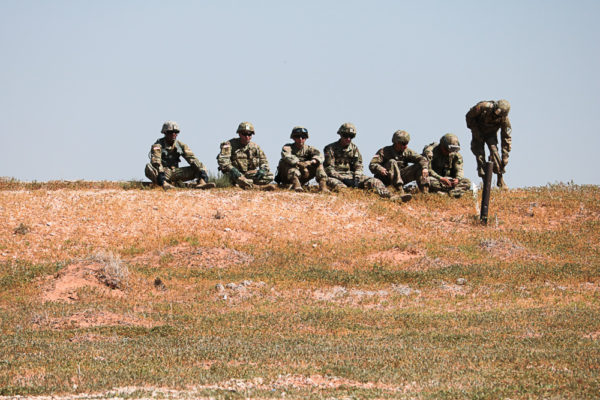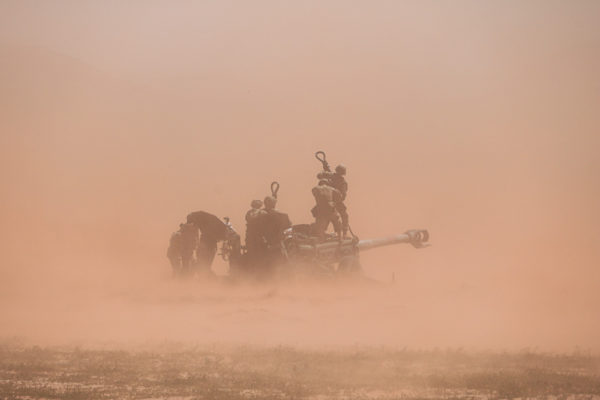EL PASO – The Fort Bliss Army Installation in this far west Texas city is considered one of the best possible locations for combat training in the United States because its harsh desert climate and terrain are near perfect simulations of deployment locations in some Middle East countries like Afghanistan and Iraq.
Frequent near-blinding dust storms and blazing heat are among the weather conditions prevalent in the area surrounding Fort Bliss as well as in Afghanistan and Iraq where the U.S. currently has 11,000 combat troops.

Soldiers of the 2nd Battalion 3rd Brigade Field Artillery (2-3FA) recently participated in air assault training in a desert clearing off Route Grey in Fort Bliss in northeast El Paso.
Fort Bliss is the largest installation in the United States Army Forces Command (FORSCOM) with an area of about 1,700 square miles. According to facts from Military Installations, there are 27,132 active duty soldiers at Fort Bliss.
With 992,000 acres of maneuver area, it’s the largest base in the country, with more land than even the National Training Center in Fort Irwin, California which has 642,000 acres. According to the 2010 census, there are 8,845 soldiers in Fort Irwin.
“We’re out here today in beautiful El Paso doing some air assault training. What we’re doing today is called elevator training,” 19-year-old Private First Class Zachary Watkins said.
Soldiers were training recently to hook up an M777 Howitzer gun to a Boeing CH-47 Chinook helicopter. The Howitzer training is very useful in places like Afghanistan and Iraq, soldiers said.

During a September press briefing for UTEP Borderzine students, Major Shea Asis explained why the exercise is essential for soldiers who deploy to areas of the Middle East.
“In Afghanistan I can’t get these big trucks to certain locations because it’s too dangerous or it takes too long,” Asis said. “Whatever the case is, the quickest way I can get a Howitzer to the battlespace and in action is through a helicopter and that’s generally how all operations are done in Afghanistan.”
During the training exercise in El Paso, groups of soldiers of the 2-3FA were positioned on a small hill as they awaited their group’s turn to train.
Private First Class Gabriel Ziacik described the training like this: “We’re coming in with our Howitzers, dropping them, shooting off some rounds then picking them back up. We’re training for the hooking up and dropping off of the Howitzers.”

Asis explained the procedure in more detail. “For lack of better words, it’s got to have bubble wrap on key components. This whole thing takes hours to do. When you go into combat speed, they’ve got literally 30 minutes or less to do it in so this is kind of a big deal.”
Training at Fort Bliss provides numerous advantages for soldiers who have been deployed or could potentially be deployed to desert climates. Staff Sergeant Christopher Campo, who has been deployed twice to Iraq said training in a desert environment “gets you used to operating in high temperatures –– it conditions your body.”
Iraq, along with many other Middle Eastern countries, has long, dry summers and temperatures which can soar above 120 degrees Fahrenheit. Fort Bliss and the surrounding city of El Paso can also reach these extremely high temperatures. Soldiers do not get any specific training for desert environments but the extensive training hours in the El Paso desert prepares them very well for the extreme climate conditions in the Middle East.
In addition, El Paso and the Middle East have very similar rugged physical landscapes. Sergeant Austin Nolan, who has been deployed to Afghanistan, noted that El Paso, “looks extremely similar to Afghanistan, especially with the mountains and the heat. So this is some pretty realistic training.”
Nolan was deployed from Fort Campbell, Kentucky, which has a lot of lush greenery, a stark contrast to the desert of Afghanistan.

Soldiers agree that training for combat in the El Paso environment can adequately prepare them for desert climates like those in the Middle East.
“The climate here is very similar, along with the terrain. It’s very mountainous, a lot of sand dunes around and dirt everywhere and very little vegetation. It’s nice. I think it will prepare me very well,” Watkins said.
For some soldiers who have only experienced tropical or colder climates, adapting to the hot, dry desert is vital for a successful deployment to similar places. “The best way to adapt is to just do it,” Nolan said.
At the same time, some soldiers say that adapting El Paso’s climate and landscape takes time, and not all soldiers are easily capable of the change.
“Some people come from colder climates and never adapt to the heat. Other people come from Alaska and they’ll train in the heat and they’ll be good from the start,” Campo said. “It really depends on the individual and their conditioning.”
Watkins, originally from Pinckney, Michigan, believes training in El Paso has helped him tremendously.
“I got really used to doing things in Michigan where the elevation is pretty low so there’s a higher level of oxygen there –– it’s easy to run, work out, or do any job basically,” said Watkins. “Here it acclimates you to the higher temperatures along with higher elevation so it gets you more used to the conditions of Afghanistan or Iraq.”

